Four Great Inventions
The Four Great Inventions (simplified Chinese: 四大发明; traditional Chinese: 四大發明) are inventions from ancient China that are celebrated in Chinese culture for their historical significance and as symbols of ancient China's advanced science and technology.[1]
| Four Great Inventions | |||||||||||||||
|---|---|---|---|---|---|---|---|---|---|---|---|---|---|---|---|
| Traditional Chinese | 四大發明 | ||||||||||||||
| Simplified Chinese | 四大发明 | ||||||||||||||
| Literal meaning | four great inventions | ||||||||||||||
| |||||||||||||||
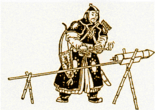 |
| History of science and technology in China |
|---|
| By subject |
| By era |
According to Chinaculture.org the Four Great Inventions are:
These four inventions had a profound impact on the development of civilization throughout the world. However, some modern Chinese scholars have opined that other Chinese inventions were perhaps more sophisticated and had a greater impact on Chinese civilization – the Four Great Inventions serve merely to highlight the technological interaction between East and West.[6]
Name
Although Chinese culture is replete with lists of significant works or achievements (e.g. Four Great Beauties, Four Great Classical Novels, Four Books and Five Classics, etc.), the concept of the Four Great Inventions originated from the West, and is adapted from the European intellectual and rhetorical commonplace of the Three Great (or, more properly, Greatest) Inventions. This commonplace spread rapidly throughout Europe in the 16th century and was appropriated only in modern times by sinologists and Chinese scholars. The origin of the Three Great Inventions—these being the printing press, firearms, and the nautical compass—was originally ascribed to Europe, and specifically to Germany in the case of the printing press and firearms. These inventions were a badge of honor to modern Europeans, who proclaimed that there was nothing to equal them among the ancient Greeks and Romans. After reports by Portuguese sailors and Spanish missionaries began to filter back to Europe beginning in the 1530s, the notion that these inventions had existed for centuries in China took hold. By 1620, when Francis Bacon wrote in his Instauratio magna that "printing, gunpowder, and the nautical compass . . . have altered the face and state of the world: first, in literary matters; second, in warfare; third, in navigation," this was hardly an original idea to most learned Europeans.[7]
In the 19th century, Karl Marx commented on the importance of gunpowder, the compass and printing, "Gunpowder, the compass, and the printing press were the three great inventions which ushered in bourgeois society. Gunpowder blew up the knightly class, the compass discovered the world market and found the colonies, and the printing press was the instrument of Protestantism and the regeneration of science in general; the most powerful lever for creating the intellectual prerequisites."[8]
Western writers and scholars from the 19th century onwards commonly attributed these inventions to China. The missionary and sinologist Joseph Edkins (1823–1905), comparing China with Japan, noted that for all of Japan's virtues, it did not make inventions as significant as paper-making, printing, the compass and gunpowder.[9] Edkins' notes on these inventions were mentioned in an 1859 review in the journal Athenaeum, comparing the contemporary science and technology in China and Japan.[10] Other examples include, in Johnson's New Universal Cyclopædia: A Scientific and Popular Treasury of Useful Knowledge in 1880,[11] The Chautauquan in 1887,[12] and by the sinologist, Berthold Laufer in 1915.[13] None of these, however, referred to four inventions or called them "great."
In the 20th century, this list was popularized and augmented by the noted British biochemist, historian, and sinologist Joseph Needham, who devoted the later part of his life to studying the science and civilization of ancient China.[14]
Inventions
Compass
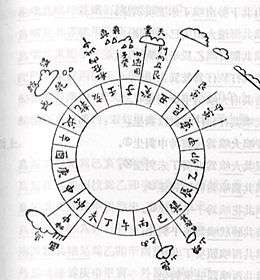
A lodestone compass was used in China during the Han Dynasty between the 2nd century BCE and 1st century CE, where it was called the "south-governor" (sīnán 司南).[15] It was not used for navigation, but rather for geomancy and fortune-telling.[15] The earliest reference to a magnetic device used for navigation is in a Song Dynasty book dated to 1040-1044, where there is a description of an iron "south-pointing fish" floating in a bowl of water, aligning itself to the south. The device is recommended as a means of orientation "in the obscurity of the night."[16] The first suspended magnetic needle compass was written of by Shen Kuo in his book of 1088.
For most of Chinese history, the compass that remained in use was in the form of a magnetic needle floating in a bowl of water.[17] According to Needham, the Chinese in the Song Dynasty and continuing Yuan Dynasty did make use of a dry compass, although this type never became as widely used in China as the wet compass.[18]
The dry compass used in China was a dry suspension compass, a wooden frame crafted in the shape of a turtle hung upside down by a board, with the lodestone sealed in by wax, and if rotated, the needle at the tail would always point in the northern cardinal direction.[18] Although the 14th-century European compass-card in box frame and dry pivot needle was adopted in China after its use was taken by Japanese pirates in the 16th century (who had in turn learned of it from Europeans), the Chinese design of the suspended dry compass persisted in use well into the 18th century.[14]
Gunpowder
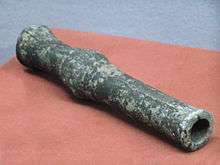
Gunpowder was invented in the 9th century by Chinese alchemists searching for an elixir of immortality.[19] By the time the Song Dynasty treatise, Wujing Zongyao (武经总要), was written by Zeng Gongliang and Yang Weide in 1044, the various Chinese formulas for gunpowder held levels of nitrate in the range of 27% to 50%.[20] By the end of the 12th century, Chinese formulas of gunpowder had a level of nitrate capable of bursting through cast iron metal containers, in the form of the earliest hollow, gunpowder-filled grenade bombs.[21]
In 1280, the bomb store of the large gunpowder arsenal at Weiyang accidentally caught fire, which produced such a large explosion that a team of inspectors at the site a week later deduced that 100 guards had been killed instantly, with wooden beams and pillars blown sky high and landing at a distance of over 10 li (~2 mi. or ~3.2 km) away from the explosion.[22]
By the time of Hanzo Yu and his Huolongjing (which describes military applications of gunpowder in great detail) in the mid-14th century, the explosive potential of gunpowder was perfected, as the level of nitrate in gunpowder formulas had risen to a range of 12% to 91%,[20] with at least 6 different formulas in use that are considered to have maximum explosive potential for gunpowder.[20] By that time, the Chinese had invented how to create explosive round shot by packing their hollow shells with this nitrate-enhanced gunpowder.[23] An excavated trove of early Ming land mines showed that corned gunpowder was present in China by 1370. There is evidence suggesting that corned powder may have been used in East Asia from as far back as the thirteenth century.[24]
Papermaking
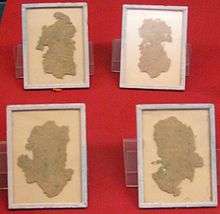
Papermaking has traditionally been traced to China about AD 105, when Cai Lun, an official attached to the Imperial court during the Han Dynasty (202 BC-AD 220), created a sheet of paper using mulberry and other bast fibres along with fishnets, old rags, and hemp waste.[25] However, a recent archaeological discovery has been reported from Gansu of paper with Chinese characters on it dating to 8 BC.[26]
While paper used for wrapping and padding was used in China since the 2nd century BC,[27] paper used as a writing medium only became widespread by the 3rd century.[28] By the 6th century in China, sheets of paper were beginning to be used for toilet paper as well.[29] During the Tang Dynasty (618–907) paper was folded and sewn into square bags to preserve the flavor of tea.[27] The Song Dynasty (960–1279) that followed was the first government to issue paper currency.
Printing
The Chinese invention of woodblock printing, at some point before the first dated book in 868 (the Diamond Sutra), produced the world's first print culture. According to A. Hyatt Mayor, curator at the Metropolitan Museum of Art, "it was the Chinese who really invented the means of communication that was to dominate until our age."[30] Woodblock printing was better suited to Chinese characters than movable type, which the Chinese also invented, but which did not replace woodblock printing. Western printing presses, although introduced in the 16th century, were not widely used in China until the 19th century. China, along with Korea, was one of the last countries to adopt them.[31]
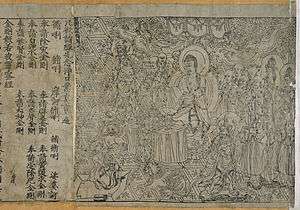
Woodblock printing for textiles, on the other hand, preceded text printing by centuries in all cultures, and is first found in China at around 220.[32] It reached Europe by the 14th century or before, via the Islamic world, and by around 1400 was being used on paper for old master prints and playing cards.[33][34]
Printing in Northern China was further advanced by the 11th century, as it was written by the Song Dynasty scientist and statesman Shen Kuo (1031–1095) that the common artisan Bi Sheng (990-1051) invented ceramic movable type printing.[35] Then there were those such as Wang Zhen (fl. 1290-1333) who invented respectively wooden type setting, which later influenced developing metal moveable type printing in Korea (1372-1377). Movable type printing was a tedious process if one were to assemble thousands of individual characters for the printing of simply one or a few books, but if used for printing thousands of books, the process was efficient and rapid enough to be successful and highly employed. Indeed, there were many cities in China where movable type printing, in wooden and metal form, was adopted by the enterprises of wealthy local families or large private industries. The Qing dynasty court sponsored enormous printing projects using woodblock movable type printing during the 18th century. Although superseded by western printing techniques, woodblock movable type printing remains in use in isolated communities in China.[36]
Cultural influence
2005 Hong Kong stamp
In 2005, the Hong Kong postal service created a special stamp issue that featured the Four Great Inventions.[37] The stamp series was first issued on August 18, 2005 during a ceremony where an enlarged first day cover was stamped.[38] Allan Chiang (Postmaster General) and Prof. Chu Ching-wu (President of the Hong Kong University of Science and Technology) marked the issue of the special stamps by personally stamping the first day cover.[38]
2008 Beijing Olympics

The Four Great Inventions was featured as one of the main themes of the opening ceremony of the 2008 Beijing Summer Olympics.[39] Paper making was represented with a dance and an ink drawing on a huge piece of paper, printing by a set of dancing printing blocks, a replica of an ancient compass was showcased, and gunpowder by the extensive firework displays during the ceremony. A survey by the Beijing Social Facts & Public Opinion Survey Center found that Beijing residents found the program on the Four Great Inventions the most moving part of the opening ceremony.[40]
Scholarly critiques
Recently, scholars have questioned the importance placed on the inventions of paper, printing, gunpowder, and the compass. Chinese scholars in particular question if too much emphasis is given to these inventions, over other significant Chinese inventions. They have pointed out that other inventions in China were perhaps more sophisticated and had a greater impact within China.[6]
In the chapter "Are the Four Major Inventions the Most Important?" of his book Ancient Chinese Inventions, Chinese historian Deng Yinke writes:[41]
The four inventions do not necessarily summarize the achievements of science and technology in ancient China. The four inventions were regarded as the most important Chinese achievements in science and technology, simply because they had a prominent position in the exchanges between the East and the West and acted as a powerful dynamic in the development of capitalism in Europe. As a matter of fact, ancient Chinese scored much more than the four major inventions: in farming, iron and copper metallurgy, exploitation of coal and petroleum, machinery, medicine, astronomy, mathematics, porcelain, silk, and wine making. The numerous inventions and discoveries greatly advanced China's productive forces and social life. Many are at least as important as the four inventions, and some are even greater than the four.
Four Great New Inventions
In August 2017, Xinhua described high-speed rail, electronic payments, bike sharing and online shopping as China's "four great new inventions".[42] However others pointed out that none of the four were actually invented in China, with modern high-speed rail originating in Japan in 1964, e-payment systems originating in the United States in the 1990s, bike sharing invented in Europe in the 1960s and online shopping invented by the Briton Michael Aldrich in 1979.[43]
See also
- Dream Pool Essays
- Gunpowder warfare
- History of science and technology in China
- List of Chinese inventions
- Science and technology of the Han Dynasty
- Technology of the Song Dynasty
References
Citations
- "The Four Great Inventions". China.org.cn. Retrieved 2007-11-11.
- "Four Great Inventions of Ancient China -- Compass". ChinaCulture.org. Archived from the original on 2007-04-09. Retrieved 2007-11-11.
- "Four Great Inventions of Ancient China -- Gunpowder". ChinaCulture.org. Archived from the original on 2007-08-28. Retrieved 2007-11-11.
- "Four Great Inventions of Ancient China -- Paper". ChinaCulture.org. Archived from the original on 2007-10-18. Retrieved 2007-11-11.
- "Four Great Inventions of Ancient China -- Printing". ChinaCulture.org. Archived from the original on 2007-08-25. Retrieved 2007-11-11.
- "Do We Need to Redefine the Top Four Inventions?". Beijing Review (35). 2008-08-26. Retrieved 2008-11-04.
- Boruchoff, 2012.
- Marx, Karl. "Division of Labour and Mechanical Workshop. Tool and Machinery". Economic Manuscripts of 1861-63.
- Edkins, Joseph (1859). The religious condition of the Chinese: With observations on the prospects of christian conversion amongst that people. Routledge-Warnes and Routledge. p. 2.
- Maurice, Frederick Denison, Charles Wentworth Dilke, Thomas Kibble Hervey, William Hepworth Dixon; et al. (1859). The Athenæum: a journal of literature, science, the fine arts, music, and the drama. J. Francis. p. 839.CS1 maint: multiple names: authors list (link)
- Frederick Augustus Porter Barnard, Arnold Guyot (1880). Johnson's New universal cyclopædia: a scientific and popular treasury of useful knowledge ... Volume 1, Part 2 of Johnson's New Universal Cyclopædia: A Scientific and Popular Treasury of Useful Knowledge. A.J. Johnson & Co. p. 924. Retrieved 2011-11-28.
Though the Chinese are skilled in imitative workmanship, they seem at present to be singularly destitute of inventive genius. Anciently, however, it must have been otherwise, for the mariner's compass, gunpowder, printing, and the manufacture of porcelain, paper, silk, and clocks, all were certainly first invented in China.
CS1 maint: uses authors parameter (link) - Theodore L. Flood, Frank Chapin Bray, Chautauqua Literary and Scientific Circle, Chautauqua Institution (1887). The Chautauquan: a weekly newsmagazine, Volume 8. 8. p. 59. Retrieved 2011-11-28.
10. "The mariner's compass." The Chinese, doubtless, originated the compass, as more than one thousand years B. C, they were able to guide themselves by the use of the loadstone, and soon after the Christian era they navigated their vessels by the use of the magnetic needle. The compasses which came into use among the Italians in the 13th century were exactly like those used in China. The earliest mention to be found of this instrument, is made by Guyot, of Provence, in 1190. The date and the author of the invention of gunpowder are lost in obscurity.
CS1 maint: uses authors parameter (link) - "Some Fundamental Ideas of Chinese Culture, Clark University (Worcester, Mass.) (1915). The Journal of international relations, Volume 5. p. 171. Retrieved 2011-11-28.
- Needham, IV 1, p. 290
- Merrill, Ronald T.; McElhinny, Michael W. (1983). The Earth's magnetic field: Its history, origin and planetary perspective (2nd printing ed.). San Francisco: Academic press. p. 1. ISBN 0-12-491242-7.
- Shu-hua, Li (July 1954). "Origine de la Boussole 11. Aimant et Bousso". Isis. Oxford: Oxford Student Publications. 45: 175–196. doi:10.1086/348315.
- Kreutz, Barbara M. (July 1973). "Mediterranean Contributions to the Medieval Mariner's Compass". Technology and Culture. 14 (3): 373. (note 21)
- Needham, IV 1, p. 255
- Buchanan (2006), p. 42
- Needham, V 7, pp. 345
- Needham, V 7, pp. 347
- Needham, V 7, pp. 209-210
- Needham, V 7, pp. 264.
- Andrade (2016), p. 110
- "Papermaking". Encyclopædia Britannica. Retrieved 2007-11-11.
- "World Archaeological Congress eNewsletter". 2006-08-11. Archived from the original on 2007-11-06. Retrieved 2007-11-11. Cite journal requires
|journal=(help) - Needham, V 1, p. 122
- Needham, V 1
- Needham, V 1, p. 123
- A Hyatt Mayor (1971). Prints and People. Nos 1-4. Princeton: Metropolitan Museum of Art. ISBN 0-691-00326-2.
- McGovern, Melvin (1967). "Early Western Presses in Korea". Korea Journal: 21–23.
- Shelagh Vainker in Anne Farrer (ed) (1990). Caves of the Thousand Buddhas. British Museum publications. p. 112. ISBN 0-7141-1447-2.CS1 maint: extra text: authors list (link)
- A Hyatt Mayor (1971). Prints and People Nos 5-18. Princeton: Metropolitan Museum of Art. ISBN 0-691-00326-2.
- Arthur M. Hind (1963) [1935]. An Introduction to a History of Woodcut. Houghton Mifflin. pp. 64–127. ISBN 0-486-20952-0.
- Needham, V 1, p. 201.
- Olympics bring unexpected luck to China's sole village using age-old movable-type printing, People's Daily
- "Four Great Inventions of Ancient China" stamp issue Archived 2008-11-20 at the Wayback Machine, Hongkong Post
- "Four Great Inventions of Ancient China" Special Stamps Issuing Ceremony Archived 2008-11-20 at the Wayback Machine, Hongkong Post
- Beijing Olympics opening features four inventions of ancient China, China Daily
- "Four great inventions" at Olympic opening warmly-welcomed, People's Daily
- Deng (2005), pp. 14.
- "Spotlight: China's "four great new inventions" in modern times - Xinhua | English.news.cn". xinhuanet.com.
- "Talent for invention? China claims other countries' discoveries". South China Morning Post. August 15, 2017.
Sources
- Andrade, Tonio, ed. (2016). The Gunpowder Age: China, Military Innovation, and the Rise of the West in World History. Princeton: Princeton University Press.
- Boruchoff, David A. (2012), "The Three Greatest Inventions of Modern Times: An Idea and Its Public", in Hock, Klaus, Gesa; Mackenthun (eds.), Entangled Knowledge: Scientific Discourses and Cultural Difference, Münster: Waxmann, pp. 133–163, ISBN 978-3-8309-2729-7
- Buchanan, Brenda J., ed. (2006). Gunpowder, Explosives and the State: A Technological History. Aldershot: Ashgate. ISBN 0-7546-5259-9.
- Deng Yinke (2005). Ancient Chinese Inventions. Translated by Wang Pingxing. Beijing: China Intercontinental Press. ISBN 7-5085-0837-8.
- Li Shu-hua (1954). "Origine de la Boussole 11. Aimant et Boussole". Isis. Vol. 45 no. 2: July. Oxford. pp. 175–196.
- Needham, Joseph (1962). Physics and Physical Technology, Part 1, Physics. Science and Civilisation in China. Volume 4. Cambridge, England: Cambridge University Press.
- Needham, Joseph, ed. (1985). Chemistry and Chemical Technology, Part 1, Tsien Hsuen-Hsuin, Paper and Printing. Science and Civilisation in China. Volume 5. Cambridge: Cambridge University Press.
- Needham, Joseph, ed. (1994). Chemistry and Chemical Technology, Part 7, Robin D.S. Yates, Krzysztof Gawlikowski, Edward McEwen, Wang Ling (collaborators) Military Technology; the Gunpowder Epic. Science and Civilisation in China. Volume 5. Cambridge: Cambridge University Press.